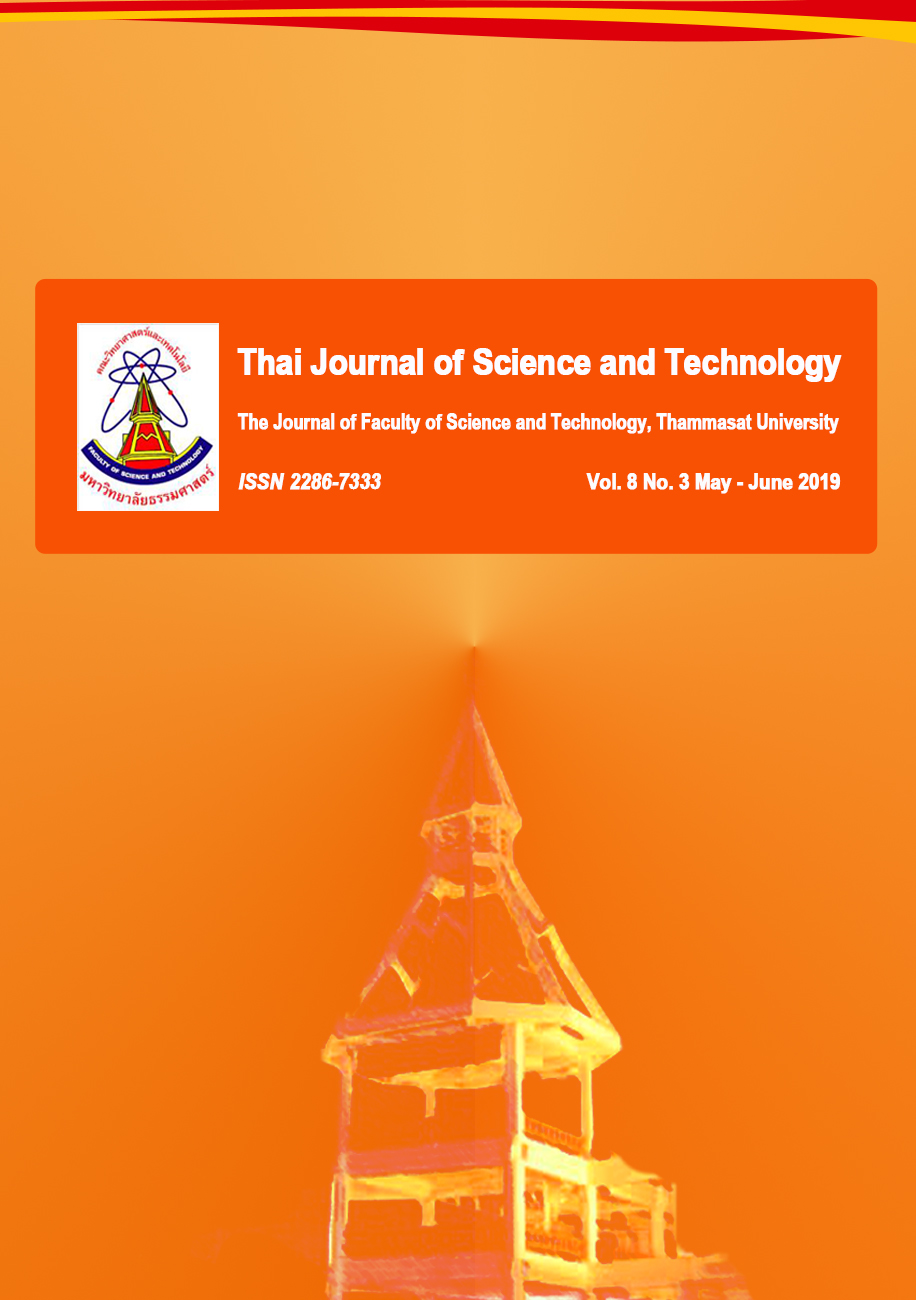การประเมินความสัมพันธ์ทางพันธุกรรมของกล้วยจีโนม AAA ด้วยเทคนิคแฮตอาร์เอพีดี
Main Article Content
Abstract
Abstract
Musa (AAA group) ‘Kluai Hom’ is an economic crop that generates a lot of income for Thai farmers. Nowadays, the area for growing bananas has been expanded with widespread breeding. This study, the high annealing temperature-random amplified polymorphic DNA (HAT-RAPD) technique was used to estimate the genetic relationship among 13 cultivars of Kluai Hom, using 72 random primers. The 18 primers with clear amplified products were selected to use for DNA fingerprinting, resulting in 240 DNA bands ranging from 250 to 3,000 bp. The number of polymorphic bands was 199 (82.92 %). Furthermore, a dendogram was constructed based on similarity coefficients using UPGMA together with the NTSYS-pc version 2.01e. The dendrograms showed three major groups which similarity coefficients ranging from 0.65 to 0.91. The result of this research could further be useful for planning conservation and breeding program.
Keywords: Kluai Hom; Musa; genetic relationship; DNA marker; HAT-RAPD
Article Details
บทความที่ได้รับการตีพิมพ์เป็นลิขสิทธิ์ของคณะวิทยาศาสตร์และเทคโนโลยี มหาวิทยาลัยธรรมศาสตร์ ข้อความที่ปรากฏในแต่ละเรื่องของวารสารเล่มนี้เป็นเพียงความเห็นส่วนตัวของผู้เขียน ไม่มีความเกี่ยวข้องกับคณะวิทยาศาสตร์และเทคโนโลยี หรือคณาจารย์ท่านอื่นในมหาวิทยาลัยธรรมศาสตร์ ผู้เขียนต้องยืนยันว่าความรับผิดชอบต่อทุกข้อความที่นำเสนอไว้ในบทความของตน หากมีข้อผิดพลาดหรือความไม่ถูกต้องใด ๆ
References
ฐิตาพร มณีเนตร, ธีระชัย ธนานันต์ และนฤมล ธนานันต์, 2560, การวิเคราะห์ความสัมพันธ์ทางพันธุกรรมและการจำแนกกล้วยไม้สกุลหวายหมู่แคลิสตาด้วยเครื่องหมายแฮตอาร์เอพีดี, Thai J. Sci. Technol. 6: 316-323.
ฐิติพร โท้มโสภา, เปรมณัช ขุนปักษี, ธีระชัย ธนา นันต์ และนฤมล ธนานันต์, 2556, การศึกษาความหลากหลายทางพันธุกรรมของกล้วยสกุลมิวซาด้วยเทคนิคแฮตอาร์เอพีดี, Thai J. Genet. S1: 201-205.
นฤมล ธนานันต์, สุรีย์พร พุ่มเอี่ยม และธีระชัย ธนา นันต์, 2556, การจำแนกพันธุ์และความ สัมพันธ์ทางพันธุกรรมของกล้วยไม้ช้างและลูกผสมด้วยเครื่องหมายแฮตอาร์เอพีดี, ว.วิทยาศาสตร์และเทคโนโลยี 21: 360-370.
เบญจมาศ ศิลาย้อย, 2558, กล้วย, สำนักพิมพ์มหาวิทยาลัยเกษตรศาสตร์, กรุงเทพฯ.
พรประภา ศิริเทพทวี, ฐิตาพร มณีเนตร, เปรมณัช ขุนปักษี, ธีระชัย ธนานันต์ และนฤมล ธนานันต์, 2560, การประเมินความสัมพันธ์ทางพันธุกรรมและการจำแนกกล้วยด้วยเครื่องหมายสก็อต, Thai J. Sci. Technol. 6: 271-278.
ราชันย์ ภู่มา และสมราน สุดดี, 2557, ชื่อพรรณไม้แห่งประเทศไทย เต็ม สมิตินันท์ ฉบับแก้ไขเพิ่มเติม พ.ศ. 2557, สำนักงานหอพรรณไม้สำนักวิจัยการอนุรักษ์ป่าไม้และพันธุ์พืช กรมอุทยานแห่งชาติสัตว์ป่าและพันธุ์พืช, กรุงเทพฯ.
สำนักงานพัฒนาเศรษฐกิจจากฐานชีวภาพ (องค์ การมหาชน), 2554, บัญชีรายการทรัพย์สินชีวภาพกล้วย, สำนักงานพัฒนาเศรษฐกิจจากฐานชีวภาพ (องค์การมหาชน), กรุงเทพฯ.
สุรกฤษฏิ์ สุขสกุล, ธีระชัย ธนานันต์ และนฤมล ธนานันต์, 2561, การประเมินความสัมพันธ์ทางพันธุกรรมและการจำแนกบัวสายและลูกผสมด้วยแฮตอาร์เอพีดี, Thai J. Sci. Technol. 7: 418-426.
สุรีพร เกตุงาม, 2546, เครื่องหมายดีเอ็นเอในงานปรับปรุงพันธุ์พืช, ว.วิชาการ ม.อบ. มหาวิทยา ลัยอุบลราชธานี 5(2): 37-59.
Bello-Bello, J.J., Iglesias-Andreu, L.G., Aviles-vinas, S.A., Gomez-Uc, E., Canto-Flick, A. and Santana-Buzzy, N., 2014, Somaclonal variation in Habanero pepper (Capsicum chinense Jacq.) as assessed ISSR molecular markers, Hort. Sci. 49: 481-485.
Doyle, J.J. and Doyle, J.L., 1987, A rapid DNA isolation procedure for small quantities of fresh leaf tissue, Phytochem. Bull. 19: 11-15.
Hu J.B., Li Q. and Li J., 2011, ISSR analysis of somaclonal variation in callus-derived plants of Amorphophallus rivieri Durieu, Acta Biol. Cracov. Bot. 53/1: 120-124.
Jayanthi, M., Gupta, R., Mandal, P.K. and Singh, K.B.M., 2018, Analysis of somaclonal variation using molecular markers in in vitro regenerated Chrysanthemum cv. Pusa centenary, Int. J. Curr. Microbiol. Appl. Sci. 7: 1642-1655.
Lu, Y., Zhang, X., Pu, J., Qi, Y. and Xie, Y., 2011, Molecular assessment of genetic identity and genetic stability in banana cultivars (Musa spp.) from China using ISSR markers, Aust. J. Crop Sci. 1: 25-31.
Opara, U.L., Jacobson, D. and Al-Saady, N.A., 2010, Analysis of genetic diversity in banana cultivars (Musa cvs.) from the South of Oman using AFLP markers and classification by phylogenetic, hierarchical clustering and principal component analyses, J. Zhejiang Univ-Sci. (Biomed. & Biotech.), 11: 332-341.
Pinar, H., Unlu, M., Bircan, M., Baysal, F., Tuna, G.S., Tuna, M. and Ercisli, S, 2015, Genetic characterization of banana clones grown in Turkey based on nuclear DNA content and SRAP markers, J. Appl. Bot. Food Qual. 88: 222-227.
Rahman, M.H. and Rajora, O.P., 2001, Microsatellite DNA somaclonal variation in micropropagated trembling aspen (Populus tremuloides), Plant Cell Rep. 20: 531-536.
Rohlf, F.J., 2002, NTSYSpc Numerical Taxonomy and Multivariate Analysis System, Applied Biostatistics, Inc., New York.
Sambrook, J., Fritsch, E.F. and Maniatis, T., 1989, Molecular Cloning: A Laboratory Manual, 2nd Ed., Cold Spring Harbor Laboratory Press, New York.
Tarafdar, S., Gupta, K.S., Banerjee, S. and Shailja, D., 2017, Identification of SSR and ISSR markers associated to off-type somaclonal variants in micro-propagated banana, J. Biotech. Biochem, 3(2): 18-22.


